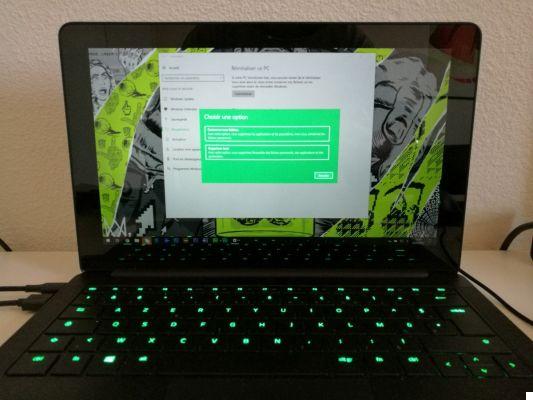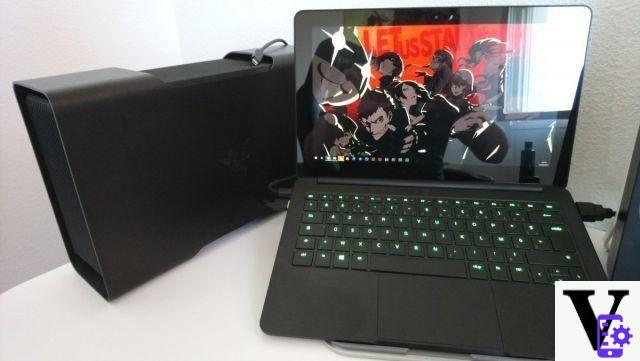The general public beginnings of eGPUs
The Thunderbolt 3 port combined with USB Type-C was properly unveiled in 2021 and gained popularity as early as 2021 after being incorporated into a few high-end laptops. Then followed the announcement of the first Razer Blade Stealth, which promised something even difficult: reconciling ultraportables and gaming, thanks to the Razer Core presented at the same time.

End of 2021, where the beginnings of a setup
The Razer Core is this small box that you simply connect with a Thunderbolt 3 cable, which allows you to connect a desktop graphics card to play on your ultrabook. After having long been an obsession for a perfume geek, the eGPU - for external GPU - then became an easily accessible and configurable product intended for the general public.
An announcement that will have caused me a thrill of pleasure. Understand: I finally had what I had always been looking for, the possibility of bringing with me an ultrabook with a day's battery life to be connected with a single cable once at home to find my screen, my keyboard, my mouse, and play until I fall asleep. So I was an early adopter, and spent my hard-earned money to get the Razer Blade Stealth first of the name, the Razer Core and a GeForce GTX 1060.
Promise and reality
The promise of the eGPU is simple: with just one cable, it was finally possible to enjoy power that was previously impossible to obtain on a laptop PC. The graphics cards of laptops were far from satisfactory at the time and the designs of gaming computers ... far from sober enough for professional use or practical on the move.
The problems of heating and consumption were no longer: because the case is external, it only had to have its own ventilation for the graphics card. As for battery consumption, the very concept is that the computer is recharging at the same time it is used. Also, you no longer need to pay attention to your battery. The more adventurous could even consider very small eGPU boxes for their travel, so they could play the way they wanted.

A conflictual relationship
The reality… was a little less beautiful. The concept was still in beta, so that drivers, motherboards and OS were not quite ready for this revolution. The first Razer Core did allow a graphics card to be plugged in, but its USB ports never worked well enough to plug in any peripheral. A concern that all boxes of this generation have known and which was resolved with the Razer Core V2 before the Razer Core X abandoned any idea of providing a USB hub as a bonus to a graphics card.
Even more difficult: getting Windows 10 to be flexible enough to allow so many devices to be added and removed in a matter of seconds. From graphic bugs to perilous sleep wakes, I have known everything. Finally, in the context where you also had an integrated Nvidia chip, it will have been some time before the relationship between the two is really well balanced and one does not suppress the other.
The eGPU has played its part
Today, eGPUs are perfect. Windows 10 like macOS accept them without flinching, the concept works perfectly and the boxes are always more accessible for ordinary people. My Razer Blade Stealth 2021 paired with the Razer Core V2 fills me with happiness. However, and particularly following the IFA 2021 ... they are no longer really of interest. And this was done in several stages.
First of all, there was Nvidia. By presenting "Max Q", the manufacturer of graphics cards has finally achieved what was thought impossible: to provide substantially the same performance between a mobile graphics card and a desktop graphics card. The market has evolved to refocus on gaming, causing product prices to soar and more concretely justifying R&D costs, its engineers have finally succeeded in finding viable performance / heating profiles to present to the general public on machines. always finer and more upscale.

A cable they said
Still, these machines are far from being ultrabooks, which is the product category mainly targeted by these eGPUs. Reconciling mobility and gaming: a niche dream finally achieved. Niche? Not really: now Apple is also launching into this small market, making it much more visible to the general public. This will motivate Microsoft and Intel to quickly resolve the problems encountered on Thunderbolt 3, in particular allowing a much smarter management of multiple graphics cards present on a single mobile system.
Finally, Intel offered quad core chips on ultrabooks, on the same line of thought as Nvidia: the demand was finally there enough to justify looking into it. Until then, a small dual core was sufficient for these machines from which we especially wanted to remove the slightest fan thanks to M chips which did not convince many people.
And the eGPU is gone
And that takes us to IFA 2021 and the presentation of the new Razer Blade Stealth. The culmination of the past few years of making the eGPU viable for the general public will simply have led to its demise, since the discoveries made will have made it obsolete.
Thanks to its Max Q designs, the Razer Blade Stealth can now integrate an Nvidia GeForce GTX 1650. Thanks to the improvement in power without real detriment to the battery, the Intel Core i7-1065G7 can propel the machine without necessarily to condemn it to an abysmal autonomy.
And finally, Windows 10 managing the relationship between the graphics chips of different organs much better, it is possible to remain quietly on the Intel HD 620 with very low consumption for the majority of the tasks, guaranteeing an exemplary longevity and not activating the GeForce GTX 1665 only when it is really necessary: in game. Thus, the idea of the “first ultrabook gaming” is well respected and always more attractive.

This possibility is due to what the eGPU has accomplished. But now, what does he have left? The ability to regularly update your graphics card, yes, but that was never really the main interest. Connect everything in one cable? The Thunderbolt 3 port is still there on the latest Blade Stealth, so a cheaper dock will still offer that possibility.
Above all, there will be the idea that allowed us to move on to laptops. As for me, I would have spent a lot of money to unlock this possibility for you: at least this is the excuse behind which I will now hide to justify my investments in recent years.
To follow us, we invite you to download our Android and iOS application. You will be able to read our articles, files, and watch our latest YouTube videos.


























